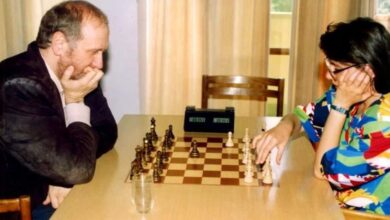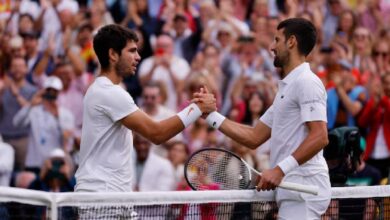GM Srinath Narayanan: There’s a consensus in world of chess that India is a superpower

In 2017, when Srinath Narayanan became a Grandmaster, only 45 Indians had managed to reach that level. Just six years later, that number is very close to doubling. Srinath’s role in Indian chess too has evolved. At the Chess Olympiad last year, he was captain of the India A team. He is also the trainer of Nihal Sarin, one of India’s most promising teenage Grandmasters.
Currently in Dubai as the manager of the upGrad Mumba Masters team, he spoke to The Indian Express about how the Global Chess League will benefit Indian chess, how he has drawn ideas from the Indian chess team to make the GCL outfit gel together, and what India must do in the coming years to capitalise on the crop of young players. Excerpts:
In GCL, teams that play with black get one more point for wins. How much pressure does this put on managers like yourself at the toss?
When we first heard of this format — all players on all six boards playing the same colour — most of us thought initially that the sides starting with white will have a very dinct and clear advantage. But over the course of the first few days, it seems that black is doing better than white. That’s a surprise. We did not expect it.
We’ve seen plenty of photos of the upGrad Mumba Masters team meeting over dinner during the league. Can you tell us the idea behind that?
Expanding our Kabaddi family! Meet our newest fan, our Grandmaster Alexander Grischuk, who quickly fell in love with the sport after we introduced him to it.@suhailchandhok @upGrad_edu @RonnieScrewvala @GCLlive@akshayakalpa @Vachier_Lagrave@viditchess @humpy_koneru… pic.twitter.com/4YpYFomCBz
— U Mumba (@umumba) June 24, 2023
https://platform.twitter.com/widgets.js
Every chess player has their own pre-game routine, so we can’t do this with breakfast or lunch. But this concept of having dinner together comes from the Indian chess team. When we play in the Olympiad and other team events, we’re a pretty close-knit unit. When you put individuals in a team, usually infighting and differences crop up. But I haven’t seen that happen with the Indian chess team so much in all my experience. This meal idea comes from there. And if you see our team, it has a heavy Indian flavour with Koneru Humpy, Vidit Gujrathi and Harika Dronavalli, who have been veterans of the Indian team. There was some thought behind picking a team like this. We knew that the players had an exing rapport.
This makes my heart full & it’s what we set out to do this year @umumba across Sports!
TEAM CULTURE
So proud of the way everyone has enjoyed the team experience and spending time with each other. No matter what happens, this already makes you winners @HarikaDronavali… https://t.co/emS1T321NZ
— Suhail Chandhok (@suhailchandhok) June 25, 2023
https://platform.twitter.com/widgets.js
How do you see this league benefitting Indian chess, particularly when you see youngsters like Gukesh D, Arjun Erigaisi and Praggnanandhaa in the same team as Magnus Carlsen? Then Raunak Sadhwani is in a team with Ian Nepomniachtchi while Nihal Sarin is with Jan-Krzysztof Duda, Shakhriyar Mamedyarov and Daniil Dubov.
Aside from being in the same team, the league offers the youngsters a platform to be in the same social environment: meeting these top players in the world over breakfast and dinner and discussing chess without any cue. In a normal traditional chess tournament where you’re playing as an individual, everyone is on their own. They have their own routines. They’re with themselves. You don’t see players having dinner together in a top tournament. Very rare!
Are you hearing this from GMs the world over: That India is a superpower in chess?
I think it’s a fairly obvious consensus. In terms of players, there’s no one even close to India. India is expected to be at the top in chess when you look at the number of rising players under the age of 20. India is a clear No. 1 at the moment.
Some of the chess superpowers, there’s Russia, USA and China. USA doesn’t have a lot of indigenous talent. Most of China’s best players are over 25 or 30. They don’t have a rising crop of talent under 20. It just doesn’t ex at the moment. Russia has always had a vibrant chess culture, but it has had its peak. Right now, Russia’s chess is no longer at its peak. So India is ahead of all these countries based on potential. Of course, there are other countries with young talent like Uzbekan. But in terms of sheer numbers, even they don’t come close to India.
What must India do in the coming years so that this young crop becomes world-beaters?
For starters, it would be great if this young crop constantly plays against the best players. Right now, only one or two of these junior players can play in a tournament, at best. We have just the one tournament at the moment: the Tata Steel Rapid and Blitz. I would see we need two or three more classical tournaments. Look at Norway Chess where Magnus and another top Norwegian GM get the chance to play.
The second thing is training and support. Right now, some of the top juniors have access to training and support. But this is not spread across the whole system. For every one promising junior who has access, there are five or 10 who have immense potential but do not have a trainer or the financial support. We need to tap into the second line of juniors and give them access to resources.








